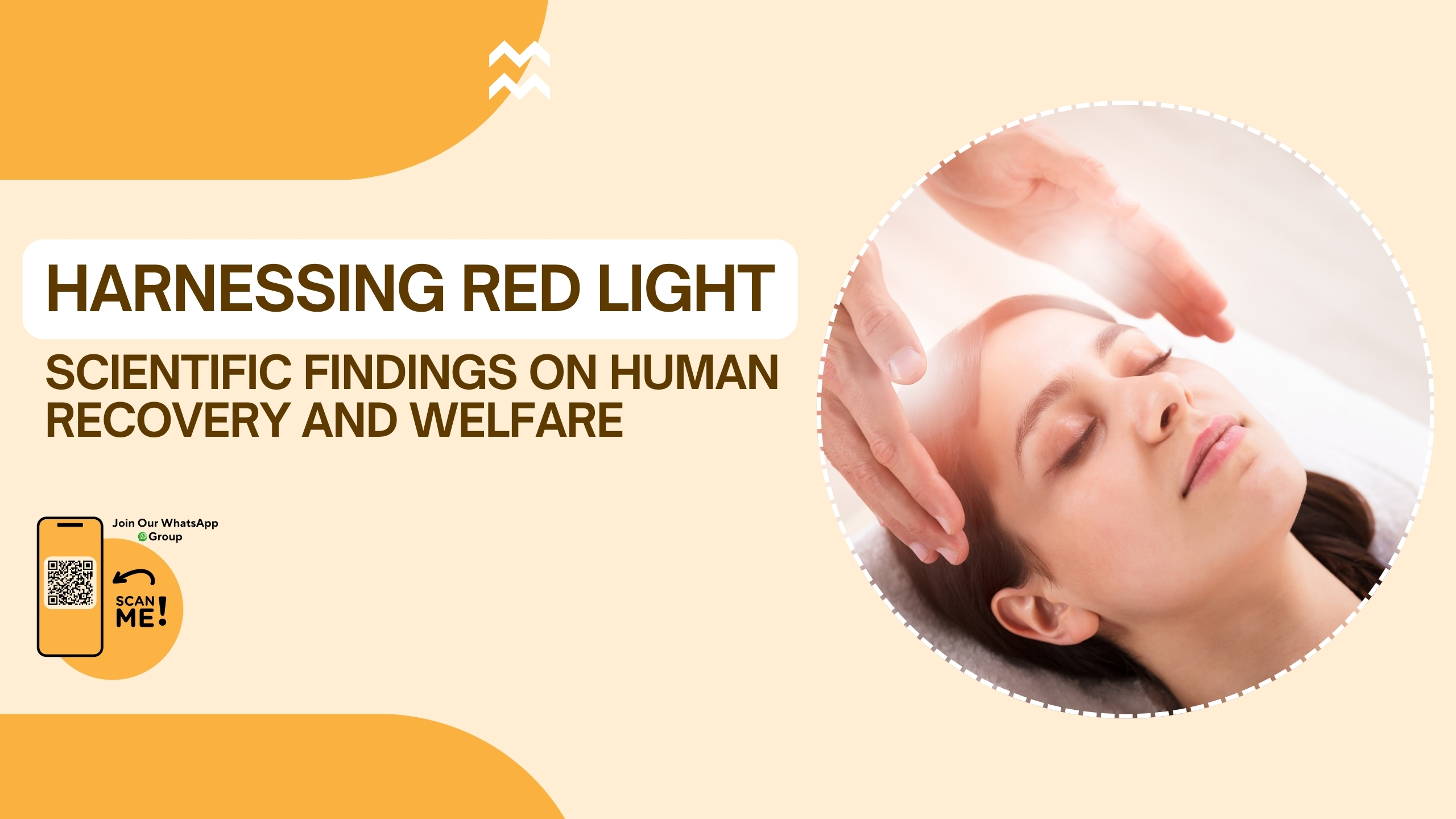INTRODUCTION –
Red and near-infrared light are used in red light therapy (RLT), also known as photobiomodulation (PBM), a new non-invasive treatment that promotes cellular healing processes.
According to recent studies, it is effective in accelerating healing, enhancing skin and vascular health, lowering pain and inflammation, and enhancing the quality of sleep.
HOW DOES IT WORKS –
Certain red (600–700 nm) and near-infrared (700–1100 nm) light wavelengths can pass through the epidermis and interact with cells, particularly mitochondria.
- The primary energy source for the majority of cellular processes, ATP (adenosive triphosphate), boosts the cells’ capacity to resist infection and speeds up the healing process.
- Reactive oxygen species, or ros, can be modulated to activate transcription factors that have a beneficial effect on cellular healing and repair.
- Nitric oxide (NO) is a strong vasodilator that improves circulation, reduces inflammation, and allows oxygen and the immune system to move freely throughout the tissue.
- RLT alters endothelial function, encouraging angiogenesis, vasodilation, and inflammation reduction. Endothelial function can be enhanced by light with varying wavelengths and intensities.

CLINICAL APPLICATIONS-BASED ON RESEARCH EVIDENCE
- Skin Rejuvenation and Anti-Aging-
- Mitochondrial cytochrome C oxidase (COX) is one of the endogenous photoreceptors that absorbs RL(red light ) and NIR (near infrared light ) photons. The following modifications result from COX activation: changes in intracellular calcium levels, production of ROS, and regulation of mitochondrial ATP.
- Hence Red light therapy, shows noticeably increased keratinocytes, can broaden the range of anti-aging treatment choices accessible to patients seeking mild and pleasant light-only skin rejuvenationdecreases wrinkles, and increases collagen synthesis
2 .Muscle Recovery and Performance-
- Research has demonstrated participants receiving Red Light Therapy reported a notable increase in repetitions to fatigue during post-treatment tasks. This suggests that red-light therapy can help enhance muscle endurance by supporting sustained physical performance.
- Reduced delayed-onset muscle soreness (DOMS)
- Red Light Therapy is highly regarded for its effectiveness in accelerating muscle repair. The therapy has been shown to decrease overall recovery time, minimize muscle tiredness and damage and Improve sleep quality, a key factor in muscle recovery
- Pain and Inflammation Management-
- Muscle soreness and fatigue are primarily caused by inflammation and oxidative stress, both of which can be significantly reduced by red light therapy.
- Studies have demonstrated that RLT helps lower blood lactate levels, creatine kinase (CK), cytokines, and other biochemical indicators linked to muscle injury.
- Cytokines: These are proteins that play a vital impact in inflammation. Lowering cytokine levels by red light therapy can help reduce inflammation in muscular tissues
- Creatine kinase an enzyme called CK is released when muscle tissue breaks down.
- Sleep and Circadian Rhythm Support-
- Exposure to red light has a beneficial effect on melatonin regulation.
- Red light therapy was shown to enhance endurance and sleep quality, suggesting that it plays a part in circadian rhythm alignment.
- Negative emotion plays a significant impact in the fragmented alterations in the REM period, which are one example of how red light can directly affect sleep. REM sleep under red light may be altered by elevated subjective alertness, anxiety, and depressive mood.
5. Improved Endothelial function-
Endothelial function can be enhanced by light with varying wavelengths and intensities. Red and NIR light’s principal targets within the cell are linked to the impact, which alters and activates secondary cellular pathways that regulate inflammation, angiogenesis, and vasodilatation.
- Recovery in ICU Patients stay –(improve muscle )
- Since extended bed rest renders patients immobile, it is well recognized that ICU patients eventually experience muscle atrophy, sarcopenia, and a widespread loss of muscle strength.
- This results in widespread tissue stress, particularly in the musculoskeletal system and due to their increased susceptibility to hypoxia and higher inhibitory amounts of nitric oxide, metabolically stressed or damaged cells and tissues appear to respond better to PBMTPhotobiomodulation therapy (red/NIR LEDs).
- Daily PBMT can reduce the length of stayof ICU patients significantly reduced ICU stay by ~30%, enhanced muscle strength and improved mobility and improve functional capacity
SAFETY –
RLT, is a non-thermal, non-ablative, atraumatic photobiomodulation treatment for skin tissue that is safeand has few known adverse effects and is typically harmless.However, consistency between research is limited by variations in treatment protocols (e.g., wavelength, intensity, time). Inappropriate use, particularly with devices used at home, can result in burns, skin irritation, or changes in pigmentation.
CONCLUSION –
Evidence supports red light therapy as an adjuvant treatment in a number of therapeutic areas, including dermatology, pain management, critical care, and vascular health. RLT shows promise in hastening recovery and enhancing quality of life. To determine the ideal parameters and long-term efficacy, additional large-scale RCTs are required to optimize clinical use and guarantee safety.
REFERENCES –
- https://pubmed.ncbi.nlm.nih.gov/29124824/
- https://pmc.ncbi.nlm.nih.gov/articles/PMC5215870
- https://pubmed.ncbi.nlm.nih.gov/26321271/
- https://doi.org/10.3390/biomedicines9030274
- https://pubmed.ncbi.nlm.nih.gov/24286286/
- https://pubmed.ncbi.nlm.nih.gov/38674067/
- https://pubmed.ncbi.nlm.nih.gov/39521711/
- https://pubmed.ncbi.nlm.nih.gov/38309304/
- https://pubmed.ncbi.nlm.nih.gov/30591412/
- https://pubmed.ncbi.nlm.nih.gov/19708800/
- https://pubmed.ncbi.nlm.nih.gov/37917978/
- https://pubmed.ncbi.nlm.nih.gov/32598231/
- https://pubmed.ncbi.nlm.nih.gov/33803396/
- https://pubmed.ncbi.nlm.nih.gov/38262071/

Written by Dr Varvanacia Suchiang BNYS , 2nd year MD

